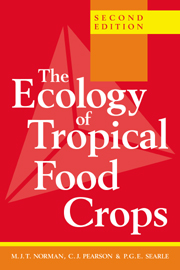5 - Rice (Oryza sativa and O. glaberrima)
Published online by Cambridge University Press: 05 June 2012
Summary
Taxonomy
The genus Oryza belongs to subfamily Bambusoideae, tribe Oryzae (Clayton & Renvoize, 1986). There are two cultivated species: O. sativa, of Asian origin, and O. glaberrima, of African origin. The former is far more important than the latter.
Chang (1976) and Nayar (1973) give general accounts of the systematics of the genus. Chang lists 20 species. The ‘sativa complex’, all of which are diploid (2n = 24), includes O. sativa and its wild relatives (O. rufipogon and O. nivara) and O. glaberrima and its wild relatives (O. barthii and O. longistaminata). Nine of the other wild species are tetraploid or exist in both diploid and tetraploid forms.
O. sativa is differentiated into three races or subspecies: indica, japonica and javanica. Their morphological and agronomic characteristics are summarised by Purseglove (1972). Intraspecific hybrids are unimportant in nature because of sterility barriers but synthetic interspecific hybrids with high yield potential (15 t ha−1) are now grown in Asia.
Origin, evolution and dispersal
There appears to be general agreement that O. sativa and O. glaberrima represent the end-points of independent and parallel domestication. It seems likely that both species developed from annual progenitors: in the case of O. sativa a species resembling O. nivara, and in the case of O. glaberrima one resembling O. barthii.
The wild relatives of O. sativa have long awns, high cross-pollination frequency, shattering spikelets and high seed dormancy, and are strongly photoperiodic.
- Type
- Chapter
- Information
- The Ecology of Tropical Food Crops , pp. 100 - 125Publisher: Cambridge University PressPrint publication year: 1995



